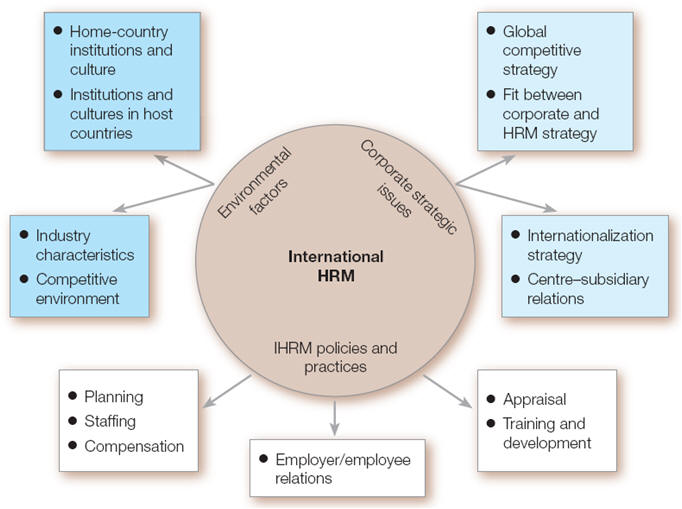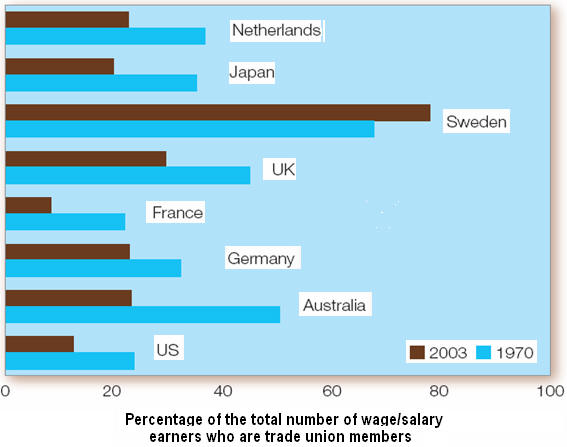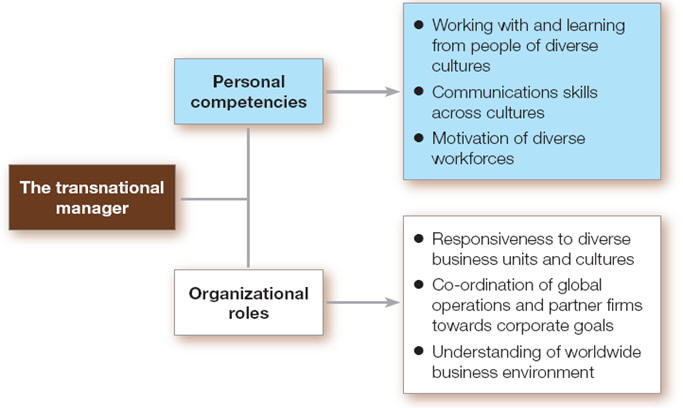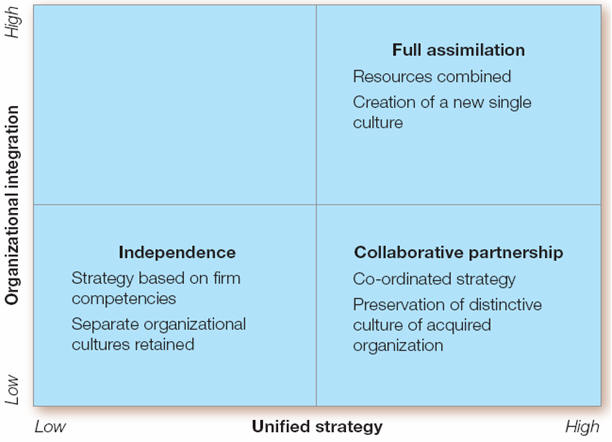How
culture bound is HRM? (page 325)
HRM
theory and practice have been products of the Anglo-American
cultural environment. Do you feel they are losing their relevance as
MNEs become more internationalized? Or do they have universal
relevance, needing only modification in different environments?
|
Relevance of HRM
theory and practice in an internationalized environment
The argument that HRM has lost
relevance rests on the Western individualist assumptions that
underlie HRM theories and practices. It can be pointed out that much
attention is devoted to aligning workers’ roles and rewards with
those of the firm – a process in which managers play a crucial part.
For example, the notion of empowerment rests on individual
responsibility, and is contrasted with the view of employees as mere
units of labor, commonly associated with large organizations.
|
 |
The cultural environment of
HRM
National cultures of both parent
and subsidiary firms influence HR policies and practices. A familiar
pattern has seen Western firms from individualistic cultures
expanding into developing countries with more collectivist cultures,
where Western HR practices must be adapted. IHRM is also adapting to
the expansion of emerging multinationals from developing countries.
Universal applicability of HRM
theory and practices
Few would claim that a single theory
could apply universally. The HRM theories discussed here take account of
different types of organization.
International HRM has evolved as firms become more
internationalized, and is now recognized as a subject area in its own
right. It is arguable that the same issues, such as manager-employee
relations, arise in all organizations, and theories are helpful in
clarifying the different roles and relations. However, it is now clear
that differing environments are central to that discussion – which was
perhaps not widely acknowledged in the past.
|
Race to the bottom?
(page 329)
What means are available
for improving working conditions and security of employment for
workers in developing countries? Will improving conditions and wages
inevitably result in investors moving operations elsewhere? Give
some country examples.
|
Improving working conditions for
workers in the developing countries
|
|
One of the
traditional means of improving working conditions is through independent trade unions, which can represent workers’
interests and negotiate on their behalf with management.. They played important
roles in both Europe and the US. However, independent trade unions are banned in
many developing countries where authoritarian governments see them as
vehicles of political dissent.
Other possibilities:
-
Democratic political
transition, by which pluralism is recognized, along with trade unions.
-
NGO activities which
publicize poor working conditions to consumers in Western markets.
|
 |
-
Government policies in host countries.
Governments are in a position to lay down conditions for employment.
Some foreign investors, such as those conscious of CSR, would
welcome such initiatives rather than be deterred by them
Will improving conditions and wages
result in investors moving operations elsewhere?
Not necessarily. Much depends on the industry
– textiles and clothing do seem to suffer from the race to the bottom.
However, most investors have multiple reasons for choosing a particular
location, and low wages is only one of them. If improving labor
standards sends investors rushing for the exit, it could be argued that
these were not the type of investors the country should have been
attracting.
Vietnam can be cited, having attracted investors when China
was becoming more costly. Mexico is another location which has benefited
from low costs. It saw investors leave in favor of China, despite the
higher costs of transport to reach US markets (see CF 4.2).
|
Rewarding workers in diverse environ-ments
(page 333)
Assume that you are the HR director
for a parent company based in the UK, with subsidiaries in the US
and China. What factors will you take into account when designing
reward systems for these differing locations?
|
First, summarize what a reward system comprises.
The company could have an identical reward system operating in these two
locations, but even if it did, it would probably not operate in practice
in the same way, as these cultural environments are so different.

Some
factors in the US subsidiary:
-
Workers are likely to be individualistic and
competitive. They are task-oriented, and performance-related pay
would appeal to them.
-
Employees here are very concerned about
benefits such as health insurance offered by the employer (note this
is mentioned in the benefits offered to McDonald’s, as featured in
the web assignment for this chapter).
-
Workers in the US tend to see a line between
their life in the organization and their personal life. Hence,
work-life balance is important to them. They might also appreciate
being able to work at home.
Some factors in the Chinese subsidiary:
-
Here, workers and managers feel strongly the
need for harmony and good personal relations.
-
Workers here are less individualistic and less
motivated simply by the reward system. Feeling appreciated by the
organization is an important factor.
-
Performance-related pay might not appeal in this more collectivist
environment.
|
The future of trade
unions (page 341)
Argue for or
against the following statement, giving your reasons:
'Trade unions
ceased to be relevant in the globalized economy'.
|
Arguments in favor of the statement: that trade unions have ceased to
be relevant:
-
Trade unions were effective in negotiation
with managers to improve working conditions when national
environments were rather self-contained. In today’s era of
globalized production, this has ceased to be the case.
-
Working conditions and employees’ contractual
rights have generally improved, especially in the developed
countries, and therefore trade unions’ reasons for existing no
longer hold true. In today’s industrializing countries, trade unions
are often very restricted, especially by authoritarian governments;
therefore they cannot play the role which they played in the earlier
industrializing countries.
-
Nowadays, employers have numerous means of
communication with employees, both direct and indirect, which did
not exist during earlier eras, when trade unions provided almost the
only means of representation for workers.
Arguments against the statement that trade unions have ceased to be
relevant:
-
Even when global companies are involved,
working conditions and employment terms are negotiated locally, and
trade union representatives, independent of management, are
legitimate voices of the employees.
-
In today’s developing and emerging economies,
conditions are often poor and workers are exploited, with little
knowledge of their legal position. The trade union can perform a
function similar to that performed by counterparts during the period
of industrialization of Western developed economies.
-
Although employers have taken many steps to
engage with employees in many organizations, these management
initiatives are directed essentially towards the organization’s
goals, not the workers’ rights. The trade union, by contrast, takes
the workers’ perspective and can negotiate on behalf of members. In
addition, many individual workers, either by inclination or fear of
losing their jobs, would not be happy about complaining individually
to managers (neither would they be very effective on their own). The
trade union, as an organization in its own right, can exert greater
bargaining power than workers individually.
|
Cross-cultural teams
(Page 346)
What are the challenges of working in
a cross-cultural team? Based on your own experience of
cross-cultural teams, make a list of suggestions for enabling them
to function smoothly, so that all feel involved in the
decision-making.
|
Cross-cultural teams and
transnational managers |
|
Team-working among people with different cultural backgrounds can be
within the organization and across organizational boundaries. Building
the understanding and trust between members which leads to successful
team-working helps to create cross-cultural competence.
The
transnational manager develops a range of competences across different
cultures, such as communication and motivation. In addition, the
transnational manager is able to coordinate disparate units into a
coherent whole, while retaining local responsiveness. |
 |
|
Challenges of working in a cross-cultural team
The challenges of
working in a cross-cultural team stem from the differing cultural
backgrounds of the team members. They will differ in their attitudes to
team work in general and in their expectations of the specific team.
Some team members are likely to be from low-context cultures and others
will be from high-context cultures. The members will have differing view
of the task orientation: some will feel that establishing social
relations is just as important as carrying out tasks, while others will
be task-oriented. Some will feel more natural in a team environment,
whereas others, especially those from individualist cultures, will find
it more difficult to adapt to a team way of working.
Suggestions
for enabling
cross-cultural teams
to function smoothly
You may probably have experience of working in
teams, if only in the context of group assessments or exercises. Some of
you may wish to contribute suggestions to the list and might probably be
familiar with groups where one or two people dominate, and the others
are turned off, possibly withdrawing from participation.
Some possible suggestions:
-
Become acquainted with the cultural
backgrounds of members, using informal conversation as an aid.
-
Select a leader who is sensitive to the
cultural differences, not necessarily the person who is most
inclined to take control of meetings.
-
Make sure all contribute, rather than let one
person dominate. The others will soon feel alienated from the
project.
-
When differences emerge on the task in hand,
allow all to contribute to resolving it, rather than going along
with the preference of the strongest member.
-
Tasks can be broken down into smaller
elements. It is important that each person is assigned a particular
task that he/she is happy with.
|
Evolving IHRM
(page 352)
How is IHRM evolving in
response to:
|

More networking and decentralized
decision-making creates greater roles for local managers, and
greater emphasis on cross-cultural management skills.
Inter-organizational networks can operate informally, cutting
through the procedural hurdles which are common in the large
organization. Interactions with other firms are central to managing
supply-chain links.
|
The rise of the transnational
manager: companies recognize the importance of coordination across
different locations, which calls on the competencies of the
transnational manager.
|
The
transnational manager develops a range of competences across different
cultures, such as communication and motivation. In addition, the
transnational manager is able to coordinate disparate units into a
coherent whole, while retaining local responsiveness.
|
 |
Employees in all locations expect
their personal needs to be taken into account by employers. This
means adapting reward systems, allowing for flexible working
patterns, and providing training and development which focuses on
personal development, as well as organizational needs.
|
First, explain what is meant by the ‘national institutional
environment’. Both public and private institutions are relevant. On the
formal level, there are government departments, regulatory bodies and
courts. The political and legal systems of the country are linked, in
providing a framework for enacting and administering laws and policies. In
developed countries, employment law, labor standards and health & safety law
tend to be more evolved and better enforced than in developing countries.
Employment rights (including the right not to be unfairly dismissed) are
usually established in employment protection legislation. We associate such
rights with developed countries, but developing countries have them in
varying degrees: for example, India has relatively strong employment
protection rights. Health and safety legislation exists in most countries,
but enforcement and redress for harmful effects differs markedly between
developed and developing countries.
The implications for HRM:
-
Companies must be aware of local employment laws,
including protection from unfair dismissal and redundancy.
-
Companies must be aware of local health and safety
rules. When there is an accident resulting in injury and damage, they
will be liable under local law for the harm if the company was
responsible. Similarly, the company may suffer harm from the activities
of another firm. In these situations, the workings of the legal system
may well be slow, cumbersome and not entirely transparent. These
characteristics are more likely to be found in developing than developed
countries (see Chapter 5)
-
What IHRM issues arise in the
cross-border merger or acquisition? In what circumstances should the
acquirer look to integrate, or alternatively, keep distinctive, the acquired
organization?
The issues which arise in cross-border M&A:
• Whether to integrate the new company or keep it separate.
• Whether the acquired company needs to be restructured, and, if so, how.
• How the acquisition fits in with the strategy of the new owner.
• How to allocate staff to key positions in the acquired firm.
• How to incorporate the differing culture of the acquired company.
Integrating the
acquired organization versus keeping it distinctive:
If the
acquired company is a well-known brand, it might be appropriate to keep its
distinctive qualities, including its structure and staff, who are committed
to the brand. If the acquirer takes over a rival company in the same sector
as itself (such as the acquisition of one supermarket chain by another),
then it is appropriate to assimilate the acquired business, rebranding
shops. A middle way is the collaborative partnership, in which the acquired
firm retains its identity and culture, but its strategy is directed largely
by its new parent (Body Shop, now owned by P&G, is an example of this
approach).
Describe the main features of Vietnam’s institutional
environment. How do these factors impact on the work environment and labor
relations?
Vietnam is making the transition from a planned economy to a
market-led one, under the guidance of its communist leaders. The state still
dominates strategic sectors, and legacies of bureaucratic state machinery
remain. Corruption remains a major problem, and progress in eliminating
corruption is slow. Market reforms and inward investors have brought
prospects of job creation on a large scale. With low wage levels compared to
China, Vietnam’s plentiful supply of keen workers is a source of comparative
advantage. Poor industrial relations have been a problem.
Workers in the key export sectors have endured poor
conditions and have little voice in labor relations. Labor unions exist, but
are state-controlled, and firms in these industries are typically foreign
investors, on whom the state is depending for job creation.
What are the attractions of Vietnam for foreign
investors?
Some which are highlighted
in the case study: |
|
What are the prospects for better employment protection
and improved labor relations in Vietnam?
Members of the National Assembly have shown they are willing
to criticize officials, and this could be a sign of growing awareness of
social and political issues at grassroots level. The government has a weak
human rights record and weak stance on employment protection. With
considerable labor unrest, the government could decide to follow China’s
example and strengthen employment rights. However, it would be reluctant to
antagonize foreign investors. Thus, the likelihood of improvement is
probably slim, especially if foreign investors are on the lookout for more
advantageous locations. On the other hand, if social unrest becomes a
perceived threat to communist leaders, they might feel that improving
workers’ rights is necessary simply to maintain political stability and
retain power.










